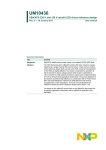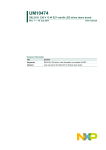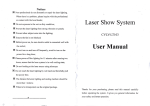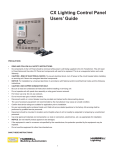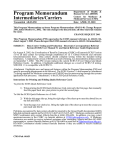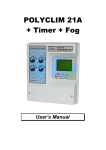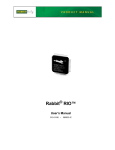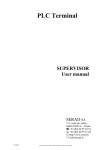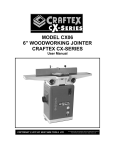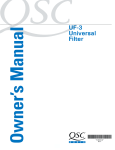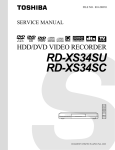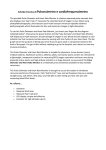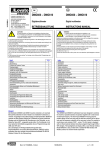Download UM10405 UBA3070 multi-channel demo board
Transcript
UM10405 UBA3070 multi-channel demo board Rev. 2 — 19 October 2011 User manual Document information Info Content Keywords UBA3070, switch mode, current source, LED driver, PWM, dimming, analog dimming, multi-channel Abstract The NXP Semiconductors UBA3070 multi-channel demo board incorporates six independent switch mode current drivers for LED strings plus an optional common input power stage. By default, the board produces 300 mA output current while the maximum output voltage is around 170 V. Multiple user-configurable options are available for the UBA3070 multi-channel demo board. This user manual describes the UBA3070 multi-channel demo board version 1.01. Refer to the UBA3070 data sheet for details on the UBA3070 device and application note AN10894 for general application information. UM10405 NXP Semiconductors UBA3070 multi-channel demo board Revision history Rev Date Description v.2 20111019 second issue v.1 20102206 first issue Contact information For more information, please visit: http://www.nxp.com For sales office addresses, please send an email to: [email protected] UM10405 User manual All information provided in this document is subject to legal disclaimers. Rev. 2 — 19 October 2011 © NXP B.V. 2011. All rights reserved. 2 of 21 UM10405 NXP Semiconductors UBA3070 multi-channel demo board 1. Introduction WARNING Lethal voltage and fire ignition hazard The non-insulated high voltages that are present when operating this product, constitute a risk of electric shock, personal injury, death and/or ignition of fire. This product is intended for evaluation purposes only. It shall be operated in a designated test area by personnel qualified according to local requirements and labor laws to work with non-insulated mains voltages and high-voltage circuits. This product shall never be operated unattended. The NXP Semiconductors UBA3070 multi-channel demo board is intended to demonstrate the switch-mode current driving capabilities of the UBA3070 device. Typical target applications for this multi-channel demonstrator are LED backlighting for LCD monitors and televisions, panel backlighting and other (RGB) multi-channel general lighting applications. Each channel can typically drive an LED string up to a length of 45 white/green/blue LEDs or 60 red LEDs in series. Each channel is individually dimmable with PWM or an analog signal. In applications where the color temperature of the LED light sources is critical, the preferred way of dimming is generally PWM. The circuit implements six Boundary Conduction Mode (BCM), buck converters and a common input power stage. The BCM buck converter is a true switch-mode current source. Boundary Conduction Mode is sometimes also referred to as Critical Conduction Mode. Remark: Unless otherwise stated all voltages are in V (DC). 2. Safety warning This multi-channel demo board is connected to a high DC voltage (up to 190 V). Avoid touching the reference board during operation. An isolated housing is mandatory when used in uncontrolled, non-laboratory environments. Galvanic isolation of the mains phase using a fixed or variable transformer (Variac) is always recommended. These devices are recognized by the symbols shown in Figure 1. 019aab174 019aab173 a. Isolated Fig 1. UM10405 User manual b. Not isolated Variac isolation symbols All information provided in this document is subject to legal disclaimers. Rev. 2 — 19 October 2011 © NXP B.V. 2011. All rights reserved. 3 of 21 UM10405 NXP Semiconductors UBA3070 multi-channel demo board 3. Features • Boundary conduction buck converter operates as a true switch-mode current source • Operates with input voltages from 12 V to 190 V and from 12 V to 600 V with some component changes • • • • User configurable output current No custom-made magnetic components required Intrinsically protected against short-circuit and open load operation Built-in over-temperature protection. 4. Technical specifications The UBA3070 multi-channel demo board default configuration implements six 300 mA switch-mode current sources capable of driving LED strings. These strings can have a total voltage drop of up to 170 V which is equivalent to 60 red or 45 green/blue/white LEDs in series. These strings can be dimensioned individually and controlled independently. The maximum supply voltage is 190 V. The board can be reconfigured to meet specific application needs. The application-specific requirements can be met changing the components listed in: • Section 8 “Alternative circuit options” on page 11 • Section 9 “Schematics” on page 12 • Section 10 “Component lists” on page 15 See reference Ref. 1 and Ref. 2 for additional information. Table 1. UM10405 User manual Default configuration main characteristics Property Value Remark output current 300 mA each channel selectable; see Ref. 2 supply voltage 12 V (DC) to 190 V (DC) depends on maximum LED string length AUX supply voltage 12 V (DC) 10 mA to 30 mA typical switching frequency 30 kHz to 145 kHz selectable; see Ref. 2 All information provided in this document is subject to legal disclaimers. Rev. 2 — 19 October 2011 © NXP B.V. 2011. All rights reserved. 4 of 21 UM10405 NXP Semiconductors UBA3070 multi-channel demo board 5. Performance data 5.1 Efficiency The UBA3070 device and the UBA3070 multi-channel demo board are more suitable for driving longer LED strings. Although there is no fundamental objection to driving short LED strings, high efficiency figures are only obtainable with long LED strings. Figure 2 gives an indication of the typical efficiency that can be expected from a UBA3070 application. In a modified UBA3070 application, a long LED string configuration of 80 LEDs in series at a 99 % efficiency can be achieved. aaa-000952 100 η (%) 80 60 40 20 0 0 40 80 120 160 Vo (V) Io = 330 mA. Fig 2. Typical efficiency curve for the UBA3070 multi-channel demo board 5.2 Output current stability The output current of the UBA3070 multi-channel demo board varies only slightly with load (that is, voltage drop across the LED string) and the circuit supply voltage. In most circumstances, the light output intensity variation is hardly visible to the human eye (if at all). If necessary, a compensation circuit can be added to the multi-channel demo board to correct for this output intensity variation. See Section 8 for more detailed information. Figure 3 and Figure 4 show the standard output current stability of the UBA3070 multi-channel demo board. UM10405 User manual All information provided in this document is subject to legal disclaimers. Rev. 2 — 19 October 2011 © NXP B.V. 2011. All rights reserved. 5 of 21 UM10405 NXP Semiconductors UBA3070 multi-channel demo board aaa-000954 350 Io (mA) 300 250 200 150 100 50 0 140 Fig 3. 150 160 170 180 190 200 210 Vsupply (V) Typical output current stability for the UBA3070 multi-channel demo board under varying supply voltage conditions The L1 inductor value (see circuit diagram in Figure 8) has an influence on the operation of the UBA3070 circuit. As can be concluded from application note AN10894, the main parameter affected is the switching frequency. Variations of up to 10 % of the L1 inductance value have practically no influence on the LED output current value. The UBA3070 application is unaffected by production-related spread of the L1 inductor. Figure 4 gives an impression of this immunity. aaa-000955 350 lo (mA) 300 250 200 150 100 50 0 450 500 550 600 650 L1 (μH) Fig 4. UM10405 User manual Typical output current stability for the UBA3070 multi-channel demo board under varying load condition All information provided in this document is subject to legal disclaimers. Rev. 2 — 19 October 2011 © NXP B.V. 2011. All rights reserved. 6 of 21 UM10405 NXP Semiconductors UBA3070 multi-channel demo board 6. Connection of the multi-channel demo board The UBA3070 multi-channel demo board connections are shown in Figure 5. When no connection is made to the dimming pin, the LEDs are at full intensity. The AUX voltage is between 12 V and 15 V. The supply voltage can be between 12 V and 190 V. The supply voltage must be at least 10 % above the LED string voltage (at rated current). It is recommended a headroom of at least 20 % is allowed. PWM dimming signal GND (0 V) GND (0 V) LED string anode Vaux LED string cathode main supply voltage Fig 5. UM10405 User manual aaa-001210 UBA3070 multi-channel demo board connections All information provided in this document is subject to legal disclaimers. Rev. 2 — 19 October 2011 © NXP B.V. 2011. All rights reserved. 7 of 21 UM10405 NXP Semiconductors UBA3070 multi-channel demo board 7. Circuit description The circuit on the UBA3070 multi-channel demo board consists of a general power Input section and six UBA3070 current source sections. Each UBA3070 current source consists of several sections: power supply input, dimming input, switching, current measurement/feedback and output. The default circuit diagram of the general power Input section plus one UBA3070 current source section is shown in Figure 8. The components are listed in Table 2. 7.1 General power input section In the default configuration, the general power input section consists of one buffer capacitor (C1) and three terminals (J1, J2, J3). J1 is the ground terminal, J2 is connected to the (12 V to 15 V) auxiliary power supply. J3 is connected to the high voltage (12 V to 190 V) main power supply. The energy propagates from the general power input section to the six local power input sections (one for each individual UBA3070 current source). The general power Input section can be adapted in such a way that it is not necessary to use an external 12 V auxiliary supply. See Section 8.1 for details. 7.2 Local power supply input section Each UBA3070 Current Source channel has an individual Local Power Input section. The power supply input section consists of two energy reservoirs and filters: • The main supply voltage reservoir and noise filter: capacitors CX01 and CX10 • The auxiliary supply voltage reservoir and noise filter: capacitors CX02 and CX08 The main power is predominantly used for providing power to the LED string. The internal circuitry of the UBA3070 IC uses the auxiliary supply voltage (12 V to 15 V). This supply also provides the power to charging and discharging MOSFET QX01 gate. The amount of energy required to charge and discharge Ciss of MOSFET QX01 determines the auxiliary supply current consumption. The current requirement can be as low as 2 mA for a small MOSFET. However, for a large MOSFET, it could be one order of magnitude higher. 7.3 Dimming input section The dimming input signal is supplied to connectors JX01 (GND) and JX02 (PWM/signal). Using a low-pass and current limiting network (RX01, RX02, CX03), the dimming input signal is supplied to the UBA3070 PWM pin. The typical target application (backlighting) normally uses PWM dimming, however, there is an option to use the analog dimming option via the same PWM pin. 7.3.1 PWM dimming When a high voltage (Vhigh, >2.5 V) is fed to the UBA3070 PWM pin, the converter is effectively disabled (It enters cycle skipping mode). A low voltage (Vlow, <0.5 V) on the same pin causes the UBA3070 to be fully enabled. The light output produced can be varied by toggling between low voltage and high voltage. The light output is exactly proportional to the duty ratio of the PWM dimming signal. In principle, any PWM frequency UM10405 User manual All information provided in this document is subject to legal disclaimers. Rev. 2 — 19 October 2011 © NXP B.V. 2011. All rights reserved. 8 of 21 UM10405 NXP Semiconductors UBA3070 multi-channel demo board is acceptable for PWM dimming. However, in reality, a low PWM frequency can give the impression that the LED string is flickering. A high frequency can result in inaccurate dimming performance and interference with the UBA3070 circuit operating frequency (see Ref. 2). A PWM frequency in the range of 100 Hz to 1 kHz is recommended for most applications including general lighting and LCD TV backlighting. The relative light output intensity is given in Equation 1 t low intensity = ------------------------------- 100 % t high + t low (1) V tlow thigh Vhigh Vlow t aaa-000957 Fig 6. Typical PWM dimming signal 7.3.2 Analog dimming By feeding an analog voltage signal to the UBA3070 PWM pin, the magnitude of the peak current flowing through the LX01 inductor can be controlled. The analog control voltage on the control pin is between 1 V and 2 V approximately. In this voltage range, the magnitude of the voltage is approximately inversely proportional to the VSENSE voltage of the UBA3070 IC. Consequently, the light intensity control matches the curve shown in Figure 7. VSENSE(max) 0.52 V 1V (typ) 1.5 V (typ) VPWM aaa-000958 Fig 7. UM10405 User manual Typical analog control light intensity is proportional to the VSENSE level All information provided in this document is subject to legal disclaimers. Rev. 2 — 19 October 2011 © NXP B.V. 2011. All rights reserved. 9 of 21 UM10405 NXP Semiconductors UBA3070 multi-channel demo board 7.4 Switching section The heart of the switching section is the UBA3070 IC (ICX01). Together with the power components QX01, DX03, LX01 and RX06, ICX01 forms the switching section. When the UBA3070 switches MOSFET QX01 on, the current in LX01 ramps up. When UBA3070 switches off QX01, the LX01 current continues to flow through DX02 and ramps down. Capacitor CX11 is added to the circuit to limit the dV/dt when MOSFET QX01 switches off. In many circumstances, this addition is necessary to guarantee correct valley detection (see UBA3070 data sheet (Ref. 1)). RX06 is a current sense resistor that is in the high current path. See Section 7.5 for further details. 7.5 Feedback section The operation of the UBA3070 Boundary mode buck converter relies on the measurement of two current levels: • The detection of the peak inductor current level while MOSFET QX01 is on (primary stroke) • The detection of zero inductor current while MOSFET QX01 is off and the current is flowing through DX02 (secondary stroke) The average current that is supplied by the switching section is exactly half the inductor peak current. This effect is because of the current ramping up and down with a constant slope and there is no dead-time between two subsequent cycles. 7.5.1 Peak current detection The peak inductor current is detected by measuring the voltage drop across RX06. This voltage drop is presented to the UBA3070 SENSE pin. The UBA3070 reacts to the detection of the peak current by switching off MOSFET QX01. 7.5.2 Direct demagnetization detection Zero inductor current is detected by measuring the inductor current with resistor RX04. The information is transferred using the a-symmetric current mirror QX02, QX03 and RX04, RX07 to the network RX03, RX05, CX04 and the dual diode DX01. When the voltage supplied to the UBA3070 MASK pin drops below 100 mV, the UBA3070 IC reacts by switching on MOSFET QX01. This way of detecting zero current (or demagnetization) of the inductor is called “direct demagnetization detection”. An alternative way of demagnetization detection is explained in Section 8. 7.6 Output section The switching section produces a sawtooth current waveform in the inductor. Current ramps-up linearly from 0 A to Ipeak and then ramps down linearly from Ipeak to 0 A. In most circumstances, the current waveform must not be fed to an LED string. Capacitor CX06 is used in the output section to reduce the ripple on the LED current for that reason. See Ref. 2 for details about the dimensioning of the ripple filter. The LED string is connected to connectors JX04 (anode of the LED string) and JX05 (cathode of the LED string). UM10405 User manual All information provided in this document is subject to legal disclaimers. Rev. 2 — 19 October 2011 © NXP B.V. 2011. All rights reserved. 10 of 21 UM10405 NXP Semiconductors UBA3070 multi-channel demo board 8. Alternative circuit options 8.1 On-board Vaux generation A linear voltage regulator is built by adding components Q1, D1, C2, R1, R2 and R3 that derives a stable Vaux voltage from the main supply voltage (terminal J3). When this circuit is added, do not apply the auxiliary supply voltage (12 V to 15 V) to terminal J2. This option allows the UBA3070 multi-channel demo board to form a single (high voltage) power supply. The main disadvantage is the additional energy that is dissipated in the linear voltage regulator. Typically, the current supplied by the linear voltage regulator is between 10 mA to 30 mA. At 100 V supply voltage, this results in 1 W to 3 W of additional power dissipation (mainly in transistor Q1). Make sure that the components can handle the extra dissipation. An example of the linear voltage regulator circuit is shown in Figure 9. The component changes are listed in Table 3. 8.2 Indirect demagnetization detection The UBA3070 multi-channel demo board offers the possibility to implement a cheaper and simpler alternative demagnetization detection circuit than the standard direct demagnetization detection option. The disadvantages of indirect demagnetization detection are: • its performance is lower with less accurate current regulation and • the possibility of false zero current detection for a dynamically changing load. However for general lighting purposes, this demagnetization detection option is adequate. Indirect demagnetization detection relies on the phenomenon that a ringing voltage appears at the drain node of MOSFET QX01 when the secondary stroke has finished. Resonance between inductor LX01 and the (parasitic) capacitance CDS of QX01 causes the ringing voltage. The resonating waveform propagates through capacitor CX09 and resistor RX10 to the RX03, RX05, CX04, DX01 network and to the UBA3070 MASK pin. The first valley of the ringing signal causes the MASK pin voltage to drop below 100 mV. This voltage drop is therefore, an indirect way of detecting demagnetization of the LX01 inductor. The UBA3070 circuit using indirect demagnetization detection is shown in Figure 10. The component changes are listed in Table 4. 8.3 Rising slope compensation The UBA3070 data sheet (Ref. 1) shows that there is always a time delay between peak current detection through the SENSE pin and the MOSFET switching off. This propagation delay is typically 140 ns and causes overshooting of the peak inductor current. The steeper the slope of the rising current, the higher the overshoot. The slope-dependent overshoot is “neutralized” using a simple high-pass filter in the peak current detection circuit. Instead of using RX06 for peak current detection, a frequency-dependent divider (RX08, RX09, CX05) is added before the signal is fed back to the SENSE pin. UM10405 User manual All information provided in this document is subject to legal disclaimers. Rev. 2 — 19 October 2011 © NXP B.V. 2011. All rights reserved. 11 of 21 UM10405 NXP Semiconductors UBA3070 multi-channel demo board Depending on the UBA3070 driver circuit implementation, some recalculation and/or experimentation is required to find proper values for RX08, RX09 and CX05. The UBA3070 circuit diagram with rising slope compensation is shown in Figure 11. The component changes are listed in Table 5. 8.4 High voltage and higher or lower current versions When some of the components of the UBA3070 multi-channel demo board are replaced with higher voltage types, the driver is able to drive longer strings. In addition, it is able to operate from a higher supply voltage while the auxiliary supply voltage remains at 12 V to 15 V. Examples of higher supply voltages are rectified mains or PFC output voltage. Table 6 shows an example of the component changes for a 100 mA driver module capable of operating from a 400 V PFC voltage. See Ref. 2 for more details about the calculation of component values. 9. Schematics to other channels Vsupply J3 C1 Cx01 Cx10 Rx07 Rx04 Qx03 Rx04a Qx02 Jx04 Cx06 Jx05 Dx02 ICx01 to other channels Vaux VCC J2 GND Rx01 PWM Jx02 MASK 1 2 Lx01 8 UBA3070 3 7 6 4 5 DRAIN Qx01 HVS GATE Rx08 RSENSE Rx03 Cx02 Cx08 Cx03 Rx02 Jx01 GND Cx11 Cx04 Dx01 Rx05 Rx06 Rx06a J1 to other channels aaa-001211 Fig 8. UM10405 User manual Default configuration UBA3070 multi-channel demo board circuit diagram with general power input and on channel All information provided in this document is subject to legal disclaimers. Rev. 2 — 19 October 2011 © NXP B.V. 2011. All rights reserved. 12 of 21 UM10405 NXP Semiconductors UBA3070 multi-channel demo board to other channels J3 Vsupply C1 R1 Cx01 Cx10 Rx07 Rx04a Rx04 R2 Qx03 Qx02 Jx04 Q1 Cx06 Vaux to other channels Jx05 Dx02 ICx01 VCC GND Rx01 PWM Jx02 D1 R3 MASK C2 Cx02 Lx01 1 2 8 UBA3070 7 3 6 4 5 DRAIN Qx01 HVS GATE Rx08 RSENSE Cx08 Rx03 Cx03 Rx02 Cx11 Jx01 Cx04 Dx01 Rx05 Rx06 Rx06a J1 GND to other channels aaa-001212 Fig 9. UBA3070 multi-channel demo board circuit diagram with modified general power input section: on-board Vaux generation to other channels Vsupply J3 C1 Cx01 Cx10 Jx03 Jx04 Cx06 Jx05 Dx02 to other channels Lx01 ICx01 Vaux VCC J2 GND Rx01 PWM Jx02 MASK Cx02 1 2 8 UBA3070 7 3 6 4 5 DRAIN HVS Rx10 Cx09 Qx01 GATE Rx08 RSENSE Cx08 Rx03 Cx03 Jx01 GND Rx02 Cx11 Cx04 Dx01 Rx05 Rx06 Rx06a J1 to other channels aaa-001213 Fig 10. UBA3070 multi-channel demo board circuit diagram with indirect demagnetization detection UM10405 User manual All information provided in this document is subject to legal disclaimers. Rev. 2 — 19 October 2011 © NXP B.V. 2011. All rights reserved. 13 of 21 UM10405 NXP Semiconductors UBA3070 multi-channel demo board to other channels Vsupply J3 C1 Cx01 Cx10 Rx07 Rx04 Qx03 Rx04a Qx02 Jx04 Cx06 Jx05 Dx02 to other channels ICx01 Vaux VCC J2 GND Rx01 PWM Jx02 MASK Cx02 1 2 Lx01 8 UBA3070 7 3 6 4 5 DRAIN HVS Qx01 GATE Rx08 RSENSE Cx08 Cx05 Rx03 Cx03 Jx01 GND Rx02 Cx11 Cx04 Dx01 Rx05 Rx09 Rx06 Rx06a J1 to other channels aaa-001214 Fig 11. UBA3070 multi-channel demo board circuit diagram for rising slope compensation UM10405 User manual All information provided in this document is subject to legal disclaimers. Rev. 2 — 19 October 2011 © NXP B.V. 2011. All rights reserved. 14 of 21 UM10405 NXP Semiconductors UBA3070 multi-channel demo board 10. Component lists Table 2. Default component list Part Qty Description and package Manufacturer Remarks ICx01 6 UBA3070; SO8 NXP Semiconductors - Q1 0 BUJ103AD; DPAK NXP Semiconductors not mounted Q1a 0 PBHV8540Z; SOT223 NXP Semiconductors not mounted Qx01 6 PHD9NQ20T; DPAK NXP Semiconductors - Qx01a 0 BSP298; SOT223 Infineon not mounted Qx02 6 PBSS5230T; SOT23 NXP Semiconductors - Qx03 6 PBHV9040T; SOT23 NXP Semiconductors - D1 0 BZX384-C13; SOD323 NXP Semiconductors not mounted Dx01 6 BAV99; SOT23 NXP dual-diode Dx02 6 BYG20J; DO-214AC Vishay Farnell 1021747 Lx01 6 470 H; ELC09D471F; 2E pitch Panasonic Farnell 8094969; 10 mm maximum C1 1 47 F, 200 V; 2E pitch Vishay Farnell 1165455; 13 mm maximum C2 0 100 nF, 50 V; 0805 - not mounted Cx01 6 10 F, 200 V; 2E pitch Vishay Farnell 1165453; 10 mm maximum Cx02 6 47 F, 25 V; 1E pitch Vishay Farnell 1165523; 10 mm maximum Cx03 6 180 pF, 50 V; 0805 - - Cx04 6 22 pF, 50 V; 0805 - - Cx05 0 varies; 0805 - not mounted Cx06 6 680 nF, 250 V; 6E pitch Vishay Farnell 1413770; maximum size 22.5 mm 7.5 mm Cx07 0 varies; 1206 - not mounted Cx08 6 100 nF, 50 V; 0805 - - Cx09 0 330 pF, 250 V; 1206 - not mounted Cx10 6 10 nF, 500 V; 1206 - - Cx11 6 220 pF, 500 V; 0805 Yageo Farnell 1284127 R1 0 100 k; 1206 - not mounted R2 0 100 k; 1206 - not mounted R3 0 100 k; 1206 - not mounted Rx01 6 1 k; 0805 - - Rx02 6 10 k; 0805 - - Rx03 6 22 k; 1206 - - Rx04 6 1.5 , 0,25 W; 1206 - - Rx04a 6 1.5 , 0.25 W; 1206 - - Rx05 6 10 k; 0805 - - Rx06 6 1.5 , 0.25 W; 1206 - - Rx06a 6 1.5 , 0.25 W; 1206 - - Rx07 6 510 ; 1206 - - Rx08 6 0 (jumper); 0805 - - Rx09 0 varies; 0805 - not mounted UM10405 User manual All information provided in this document is subject to legal disclaimers. Rev. 2 — 19 October 2011 © NXP B.V. 2011. All rights reserved. 15 of 21 UM10405 NXP Semiconductors UBA3070 multi-channel demo board Table 2. Default component list …continued Part Qty Description and package Manufacturer Remarks Rx10 0 22 k; 1206 - not mounted J1, J2, J3 1 3-pole terminal block; 1E pitch Phoenix Contact Phoenix: 1725669; Farnell: 3041360 Jx01, Jx02 6 2-pole terminal block; 1E pitch Phoenix Contact Phoenix: 1725656; Farnell: 3041359 Jx03 0 jumper wire - not mounted Jx04, Jx05 6 2-pole terminal block; 1E pitch Phoenix Contact Phoenix: 1725656; Farnell: 3041359 Table 3. Component list modification for on-board Vaux generation Part Qty Description and package Manufacturer Remarks Q1 1 BUJ103AD; DPAK NXP Semiconductors - D1 1 BZX384-C13; SOD323 NXP Semiconductors - C2 1 100 nF, 50 V; 0805 - - R1 1 100 k; 1206 - - R2 1 100 k; 1206 - - R3 1 100 k; 1206 - - 3-pole terminal block - J2 not used J1, J2, J3 1 Table 4. Component list modification for indirect demagnetization detection Part Qty Description and package Manufacturer Remarks Qx02 0 PBSS5230T; SOT23 NXP Semiconductors not mounted Qx03 0 PBHV9040T; SOT23 NXP Semiconductors not mounted Cx09 6 330 pF, 250 V; 1206 - - Rx04 0 1.5 , 0,25 W; 1206 - not mounted Rx04a 0 1.5 , 0.25 W; 1206 - not mounted Rx05 6 1 k; 0805 - - Rx07 0 510 ; 1206 - not mounted Rx10 6 22 k; 1206 - - Jx03 6 jumper wire - - Table 5. Component list modification for rising slope compensation Part Qty Description and package Manufacturer Remarks Cx05 6 varies; 0805 - application dependent Rx08 6 varies; 0805 - application dependent Rx09 6 varies; 0805 - application dependent UM10405 User manual All information provided in this document is subject to legal disclaimers. Rev. 2 — 19 October 2011 © NXP B.V. 2011. All rights reserved. 16 of 21 UM10405 NXP Semiconductors UBA3070 multi-channel demo board Table 6. Component list modification for 400 V, 100 mA version Part Qty Description Manufacturer Remarks Qx01 0 PHD9NQ20T; DPAK NXP Semiconductors not mounted Qx01a 6 BSP298; SOT223 Infineon - Lx01 6 4.7 mH, 200 mA; 2E pitch - 10 mm maximum C1 1 22 F, 400 V; 2E pitch - 13 mm maximum Cx01 6 3.3 F, 400 V; 2E pitch - 10 mm maximum Cx06 6 100 nF, 400 V; 2-6E pitch - maximum size 22.5 mm 7.5 mm Rx04 6 2.2 , 0,25 W; 1206 - - Rx04a 0 1206 - not mounted Rx06 6 2.2 , 0.25 W; 1206 - - Rx06a 0 1206 - not mounted 11. Printed-Circuit Board (PCB) The UBA3070 multi-channel demo board PCB is a single-sided board. Dimensions are approximately 155 mm 49 mm. The multi-channel demo boards are produced on 1.6 mm FR4 with single-sided 35 m copper (1 oz.). FR2 can also be used as the PCB material. The PCB can accommodate several implementations of the NXP Semiconductors UBA3070 multi-channel demo board as outlined in Section 7, Section 8, Section 9 and Section 10. The Gerber File set for the production of the PCBs is available from NXP Semiconductors. The bottom silk is normally not used for PCB production. It is only a component position reference. UM10405 User manual All information provided in this document is subject to legal disclaimers. Rev. 2 — 19 October 2011 © NXP B.V. 2011. All rights reserved. 17 of 21 UM10405 NXP Semiconductors UBA3070 multi-channel demo board aaa-001215 a. Top view aaa-001216 b. Bottom view Fig 12. PCB silk screens aaa-001217 Fig 13. Bottom copper layer: bottom view UM10405 User manual All information provided in this document is subject to legal disclaimers. Rev. 2 — 19 October 2011 © NXP B.V. 2011. All rights reserved. 18 of 21 UM10405 NXP Semiconductors UBA3070 multi-channel demo board aaa-001218 Fig 14. Bottom solder mask: bottom view 12. References UM10405 User manual [1] Data sheet — UBA3070 LED backlight driver IC. [2] Application note — AN10894 application aspects of the UBA3070 switch mode LED driver. All information provided in this document is subject to legal disclaimers. Rev. 2 — 19 October 2011 © NXP B.V. 2011. All rights reserved. 19 of 21 UM10405 NXP Semiconductors UBA3070 multi-channel demo board 13. Legal information 13.1 Definitions Draft — The document is a draft version only. The content is still under internal review and subject to formal approval, which may result in modifications or additions. NXP Semiconductors does not give any representations or warranties as to the accuracy or completeness of information included herein and shall have no liability for the consequences of use of such information. Export control — This document as well as the item(s) described herein may be subject to export control regulations. Export might require a prior authorization from competent authorities. 13.2 Disclaimers Limited warranty and liability — Information in this document is believed to be accurate and reliable. However, NXP Semiconductors does not give any representations or warranties, expressed or implied, as to the accuracy or completeness of such information and shall have no liability for the consequences of use of such information. In no event shall NXP Semiconductors be liable for any indirect, incidental, punitive, special or consequential damages (including - without limitation - lost profits, lost savings, business interruption, costs related to the removal or replacement of any products or rework charges) whether or not such damages are based on tort (including negligence), warranty, breach of contract or any other legal theory. Notwithstanding any damages that customer might incur for any reason whatsoever, NXP Semiconductors’ aggregate and cumulative liability towards customer for the products described herein shall be limited in accordance with the Terms and conditions of commercial sale of NXP Semiconductors. Right to make changes — NXP Semiconductors reserves the right to make changes to information published in this document, including without limitation specifications and product descriptions, at any time and without notice. This document supersedes and replaces all information supplied prior to the publication hereof. Suitability for use — NXP Semiconductors products are not designed, authorized or warranted to be suitable for use in life support, life-critical or safety-critical systems or equipment, nor in applications where failure or malfunction of an NXP Semiconductors product can reasonably be expected to result in personal injury, death or severe property or environmental damage. NXP Semiconductors accepts no liability for inclusion and/or use of NXP Semiconductors products in such equipment or applications and therefore such inclusion and/or use is at the customer’s own risk. Applications — Applications that are described herein for any of these products are for illustrative purposes only. NXP Semiconductors makes no representation or warranty that such applications will be suitable for the specified use without further testing or modification. Customers are responsible for the design and operation of their applications and products using NXP Semiconductors products, and NXP Semiconductors accepts no liability for any assistance with applications or customer product design. It is customer’s sole responsibility to determine whether the NXP Semiconductors product is suitable and fit for the customer’s applications and products planned, as well as for the planned application and use of customer’s third party customer(s). Customers should provide appropriate design and operating safeguards to minimize the risks associated with their applications and products. UM10405 User manual NXP Semiconductors does not accept any liability related to any default, damage, costs or problem which is based on any weakness or default in the customer’s applications or products, or the application or use by customer’s third party customer(s). Customer is responsible for doing all necessary testing for the customer’s applications and products using NXP Semiconductors products in order to avoid a default of the applications and the products or of the application or use by customer’s third party customer(s). NXP does not accept any liability in this respect. Evaluation products — This product is provided on an “as is” and “with all faults” basis for evaluation purposes only. NXP Semiconductors, its affiliates and their suppliers expressly disclaim all warranties, whether express, implied or statutory, including but not limited to the implied warranties of non-infringement, merchantability and fitness for a particular purpose. The entire risk as to the quality, or arising out of the use or performance, of this product remains with customer. In no event shall NXP Semiconductors, its affiliates or their suppliers be liable to customer for any special, indirect, consequential, punitive or incidental damages (including without limitation damages for loss of business, business interruption, loss of use, loss of data or information, and the like) arising out the use of or inability to use the product, whether or not based on tort (including negligence), strict liability, breach of contract, breach of warranty or any other theory, even if advised of the possibility of such damages. Notwithstanding any damages that customer might incur for any reason whatsoever (including without limitation, all damages referenced above and all direct or general damages), the entire liability of NXP Semiconductors, its affiliates and their suppliers and customer’s exclusive remedy for all of the foregoing shall be limited to actual damages incurred by customer based on reasonable reliance up to the greater of the amount actually paid by customer for the product or five dollars (US$5.00). The foregoing limitations, exclusions and disclaimers shall apply to the maximum extent permitted by applicable law, even if any remedy fails of its essential purpose. Safety of high-voltage evaluation products — The non-insulated high voltages that are present when operating this product, constitute a risk of electric shock, personal injury, death and/or ignition of fire. This product is intended for evaluation purposes only. It shall be operated in a designated test area by personnel that is qualified according to local requirements and labor laws to work with non-insulated mains voltages and high-voltage circuits. The product does not comply with IEC 60950 based national or regional safety standards. NXP Semiconductors does not accept any liability for damages incurred due to inappropriate use of this product or related to non-insulated high voltages. Any use of this product is at customer’s own risk and liability. The customer shall fully indemnify and hold harmless NXP Semiconductors from any liability, damages and claims resulting from the use of the product. 13.3 Trademarks Notice: All referenced brands, product names, service names and trademarks are the property of their respective owners. All information provided in this document is subject to legal disclaimers. Rev. 2 — 19 October 2011 © NXP B.V. 2011. All rights reserved. 20 of 21 UM10405 NXP Semiconductors UBA3070 multi-channel demo board 14. Contents 1 2 3 4 5 5.1 5.2 6 7 7.1 7.2 7.3 7.3.1 7.3.2 7.4 7.5 7.5.1 7.5.2 7.6 8 8.1 8.2 8.3 8.4 9 10 11 12 13 13.1 13.2 13.3 14 Introduction . . . . . . . . . . . . . . . . . . . . . . . . . . . . 3 Safety warning . . . . . . . . . . . . . . . . . . . . . . . . . . 3 Features . . . . . . . . . . . . . . . . . . . . . . . . . . . . . . . 4 Technical specifications . . . . . . . . . . . . . . . . . . 4 Performance data. . . . . . . . . . . . . . . . . . . . . . . . 5 Efficiency . . . . . . . . . . . . . . . . . . . . . . . . . . . . . 5 Output current stability . . . . . . . . . . . . . . . . . . . 5 Connection of the multi-channel demo board 7 Circuit description . . . . . . . . . . . . . . . . . . . . . . . 8 General power input section . . . . . . . . . . . . . . . 8 Local power supply input section . . . . . . . . . . . 8 Dimming input section . . . . . . . . . . . . . . . . . . . 8 PWM dimming . . . . . . . . . . . . . . . . . . . . . . . . . 8 Analog dimming . . . . . . . . . . . . . . . . . . . . . . . . 9 Switching section . . . . . . . . . . . . . . . . . . . . . . 10 Feedback section . . . . . . . . . . . . . . . . . . . . . . 10 Peak current detection . . . . . . . . . . . . . . . . . . 10 Direct demagnetization detection . . . . . . . . . . 10 Output section . . . . . . . . . . . . . . . . . . . . . . . . 10 Alternative circuit options. . . . . . . . . . . . . . . . 11 On-board Vaux generation . . . . . . . . . . . . . . . . 11 Indirect demagnetization detection . . . . . . . . . 11 Rising slope compensation. . . . . . . . . . . . . . . 11 High voltage and higher or lower current versions . . . . . . . . . . . . . . . . . . . . . . . 12 Schematics . . . . . . . . . . . . . . . . . . . . . . . . . . . . 12 Component lists. . . . . . . . . . . . . . . . . . . . . . . . 15 Printed-Circuit Board (PCB) . . . . . . . . . . . . . . 17 References . . . . . . . . . . . . . . . . . . . . . . . . . . . . 19 Legal information. . . . . . . . . . . . . . . . . . . . . . . 20 Definitions . . . . . . . . . . . . . . . . . . . . . . . . . . . . 20 Disclaimers . . . . . . . . . . . . . . . . . . . . . . . . . . . 20 Trademarks. . . . . . . . . . . . . . . . . . . . . . . . . . . 20 Contents . . . . . . . . . . . . . . . . . . . . . . . . . . . . . . 21 Please be aware that important notices concerning this document and the product(s) described herein, have been included in section ‘Legal information’. © NXP B.V. 2011. All rights reserved. For more information, please visit: http://www.nxp.com For sales office addresses, please send an email to: [email protected] Date of release: 19 October 2011 Document identifier: UM10405





















